For studio Ananas Ananas, the food is the art. ‘Can we eat it?’

[ad_1]
The sobrasada sits on a slab of black terrazzo perched on a pedestal, a straight-sided block of scoopable spiced sausage the colour of pink ochre whose floor is an undulant panorama. On a tabletop, resting on two piles of white pebbles, are charcoal corn crackers organized in overlapping circles subsequent to a matrix of entire heirloom tomatoes, cored and reduce into wedges and drizzled with black-garlic-infused olive oil. A menu affixed to a nook of the low desk appears like a museum placard and reads, partially: “crispy seaweed ribbons & labne dip; black corn crackers; miso onigiri with furikake.”
Friends at a September e-book launch get together for Montalba Architects collect on one of many Hammer Museum’s mezzanines that overlook Westwood and circle the show like hawks using thermals. No one desires to disturb the rows of ceviche on recent sorrel leaves or mounds of honeycomb toffee on a protracted, terraced stand. Nevertheless it’s the one factor on everybody’s minds: “Can we eat it?”
“It simply all the time takes a second. I’ll unfold the phrase,” says Eléna Petrossian, a founding father of Ananas Ananas food-design studio, primarily based in Los Angeles and Baja California’s Ensenada. “It’s nearly like a social experiment.”
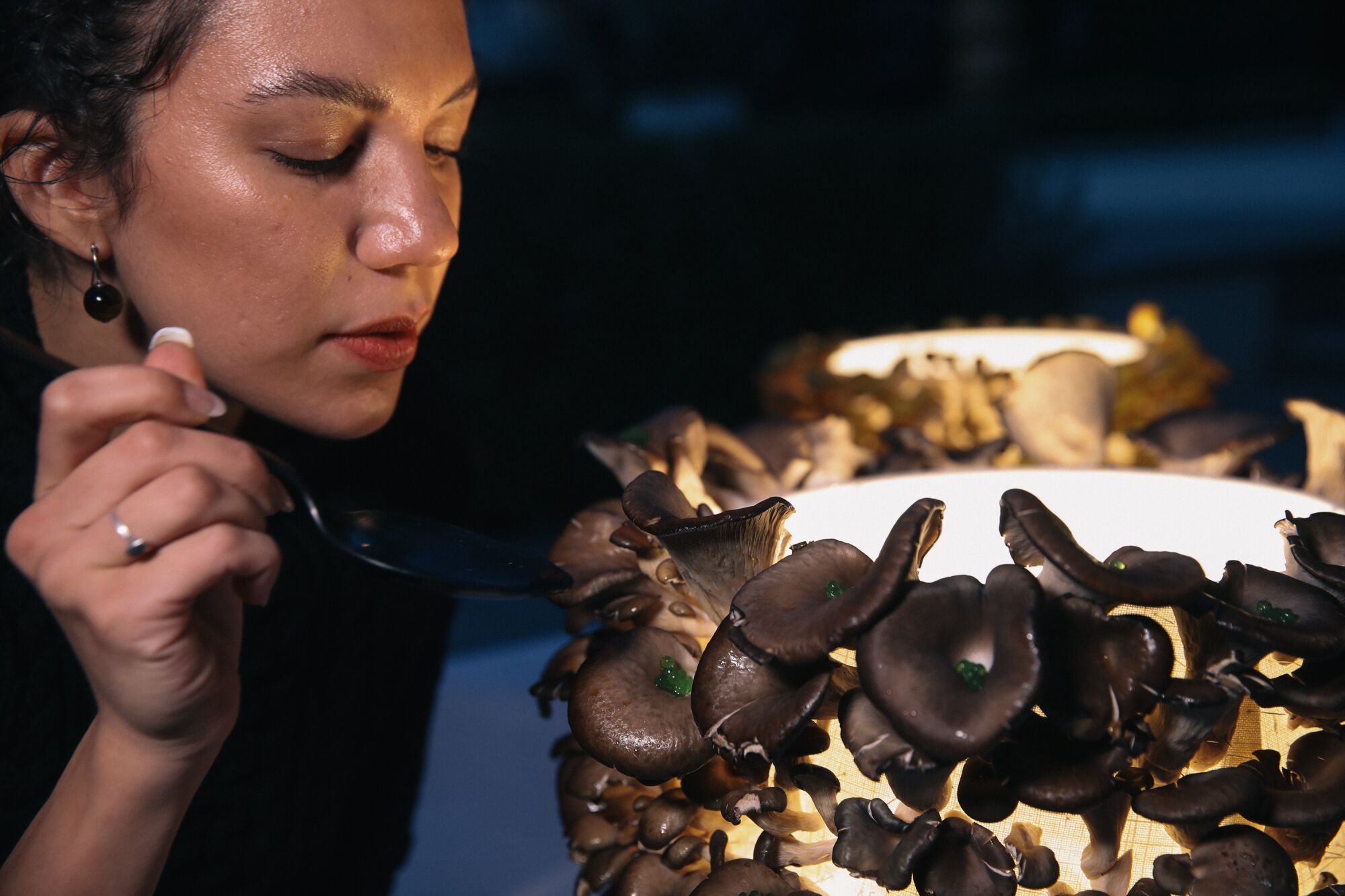
Veronica González spoons “algae” caviar onto oyster mushrooms for a mushroom-and-light set up.
(Allen J. Schaben / Los Angeles Instances)
The primary emboldened visitor squats subsequent to a concrete sculpture on the ground; formed like a form of half-cylinder, it has channels that include labne blended with chives. She picks up a dried seaweed chip to scoop some up, then eats it. Others swoop in.
Petrossian and co-founder Verónica González have designed their meals installations for retailer openings, model collaborations, gallery reveals, journal events and product launches. As artwork, design, trend and meals attain maximum cultural crisscross, Petrossian and González say they’re exploring new sensory experiences and new methods to eat.
Usually meaning no plates or utensils for his or her edible sculptures, and generally no seating or tables. As a substitute, dolmades are served on sculpted wire fencing or banks of gravel, oysters on big blocks of ice. Roasted carrots are strung from the ceiling; halved baguettes stand pointed results in thick swirls of butter that resemble waves from Japanese ukiyo-e work. A few of these are the sort of “jolie-laide assemblages” attributed to the likes of chef-artist Laila Gohar, who was lately profiled within the New Yorker and whose retail store popped up at Dries Van Noten in Los Angeles final month.
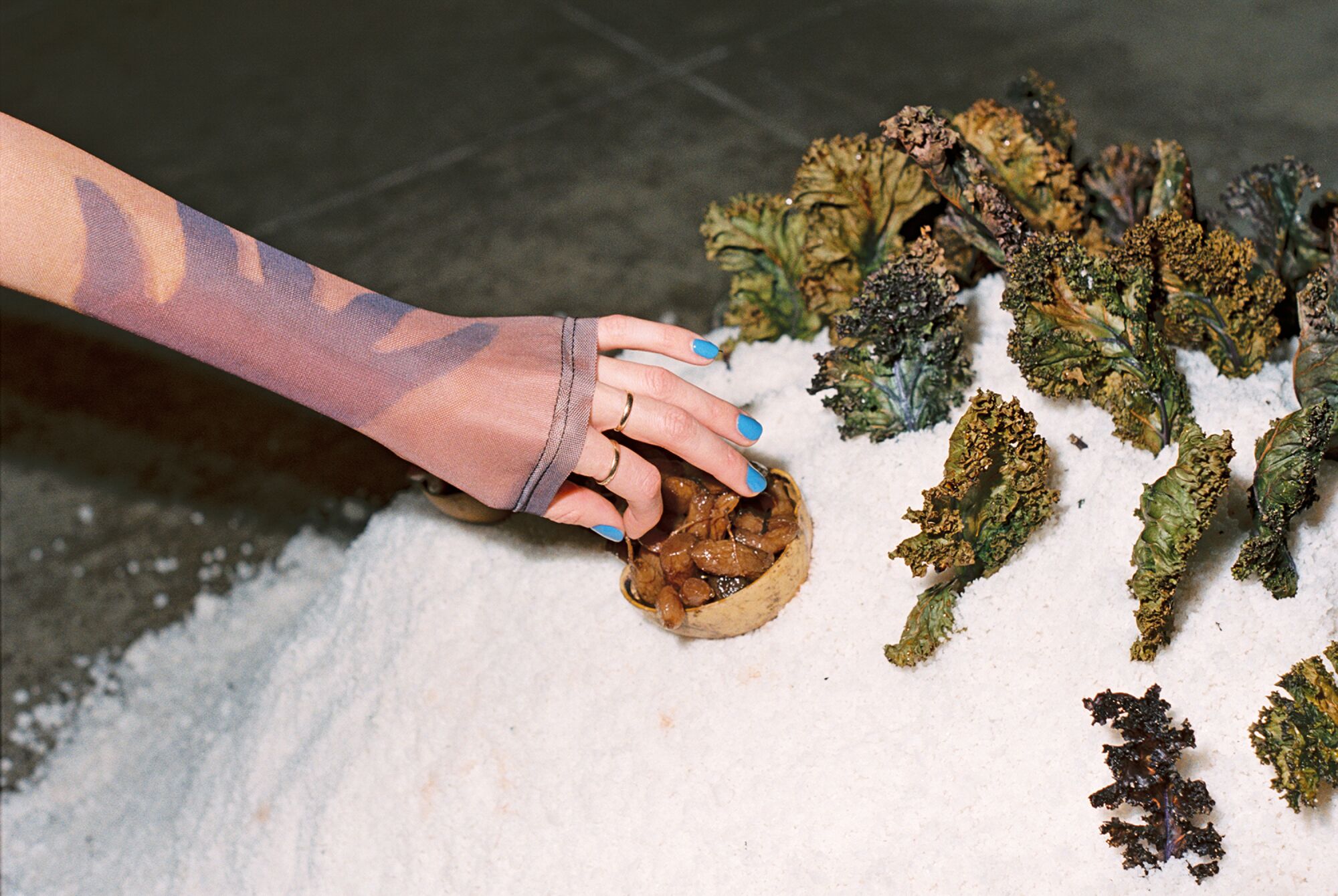
Meals studio Ananas Ananas usually eschews plates and utensils for edible sculptures.
(Maya Fuhr)
Petrossian says she and González are impressed by creators reminiscent of Dutch meals artist Marije Vogelzang, who designed a “spa remedy” for the mouth during which members are blindfolded and absolutely wrapped in a physique hammock, with a gap reduce out for the face (form of like a banana costume) by which meals could also be delivered. One hears “an audio story of their very own tongue talking” by way of headphones, “advocating for folks to pay extra consideration to their senses,” Vogelzang says in a video on her web site.
“Architects, painters, sculptors — we’re making an attempt to construct meals by bringing inspiration from different artists who work in one other medium,” Petrossian says.
“She spent the time to get to know our work and the materiality,” says David Montalba, whose structure agency’s initiatives embody the Row in Los Angeles, LAX‘s Tom Bradley Worldwide Terminal and eco-chalets in Switzerland. “We needed to inform a narrative” by meals, he explains.
González, 29, is an industrial designer by coaching who grew up in Tijuana, Mexico, and Petrossian, 32, was born and raised in Glendale — each round a number of meals. Petrossian left a profession in trend manufacturing eight years in the past and moved to Mexico Metropolis, the place the 2 met by pals whereas dwelling in Condesa.
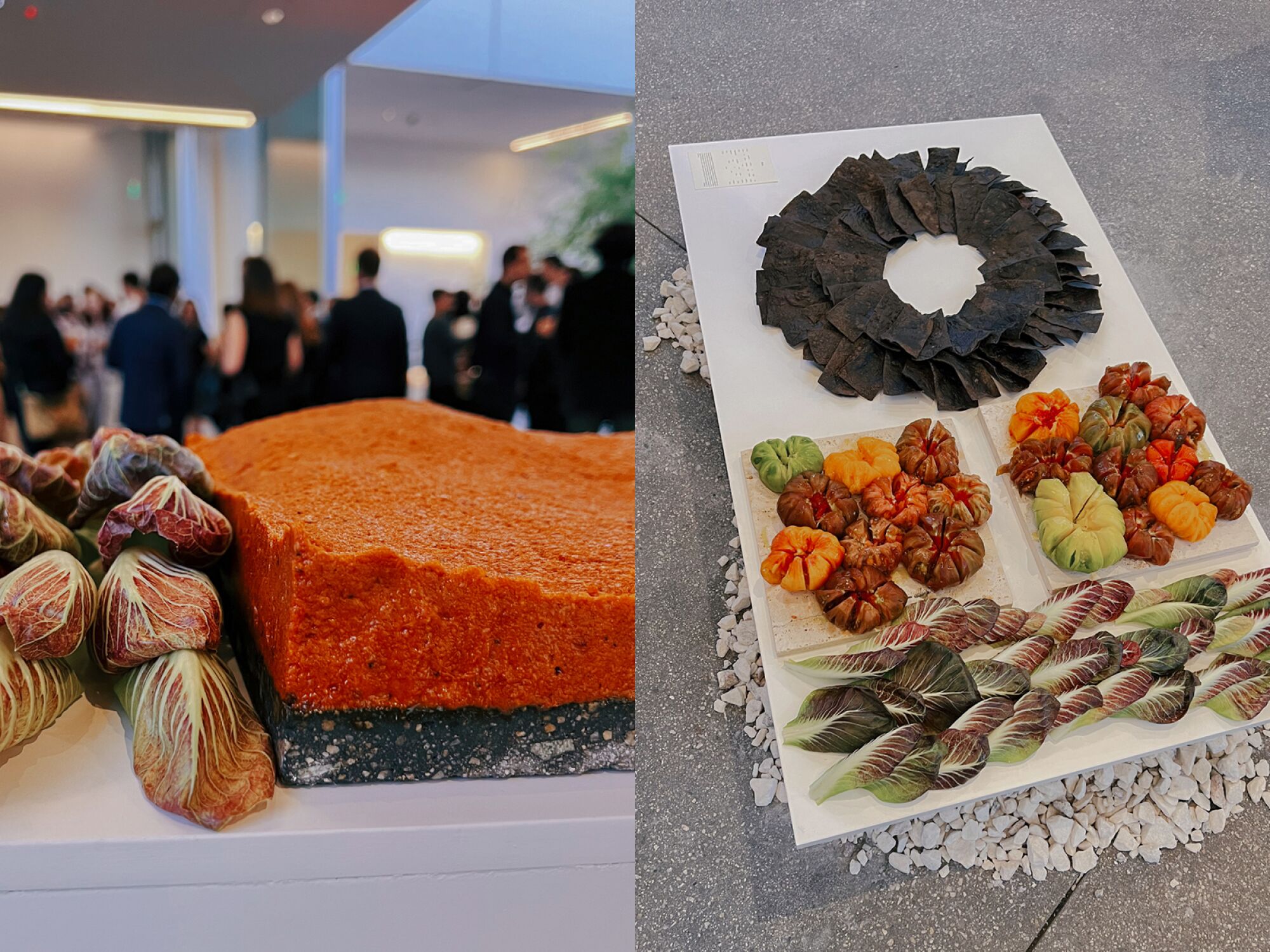
A sculpture of sobrasada with pink endive, left, and black charcoal crackers with heirloom tomatoes.
(Betty Hallock / Los Angeles Instances)
“We determined to do an set up for some pals in my lounge,” Petrossian says, “and from their reactions, we thought, ‘Oh, all people is so on this?’ We hung fruits from fishing wire. Some folks had been moving into with their mouths. Some folks had been utilizing napkins. Some had been on the sidelines staring. It was an attention-grabbing examine of taking a look at folks determine this fashion of consuming.”
For many cooks, meal planning doesn’t begin with a 3-D rendering. However for the Ananas Ananas duo, who collaborate long-distance — Petrossian now in Los Angeles, González in Ensenada since fall — it’s a part of the method of making a menu.
“We don’t ever do the identical factor twice,” Petrossian says. “We measure all the pieces, we make certain all the pieces goes to work out. Every thing is precisely to the measurements on the rendering.”
“I all the time give attention to expertise design, how objects and areas behave across the human,” González says, “how people join with the shape, the feel, the sunshine. That’s what my understanding is, what I nonetheless do in my creative observe. So when folks ask, ‘How did you find yourself in meals?’ Properly, it’s very a lot linked. We’re interested by supplies and objects as elements.”
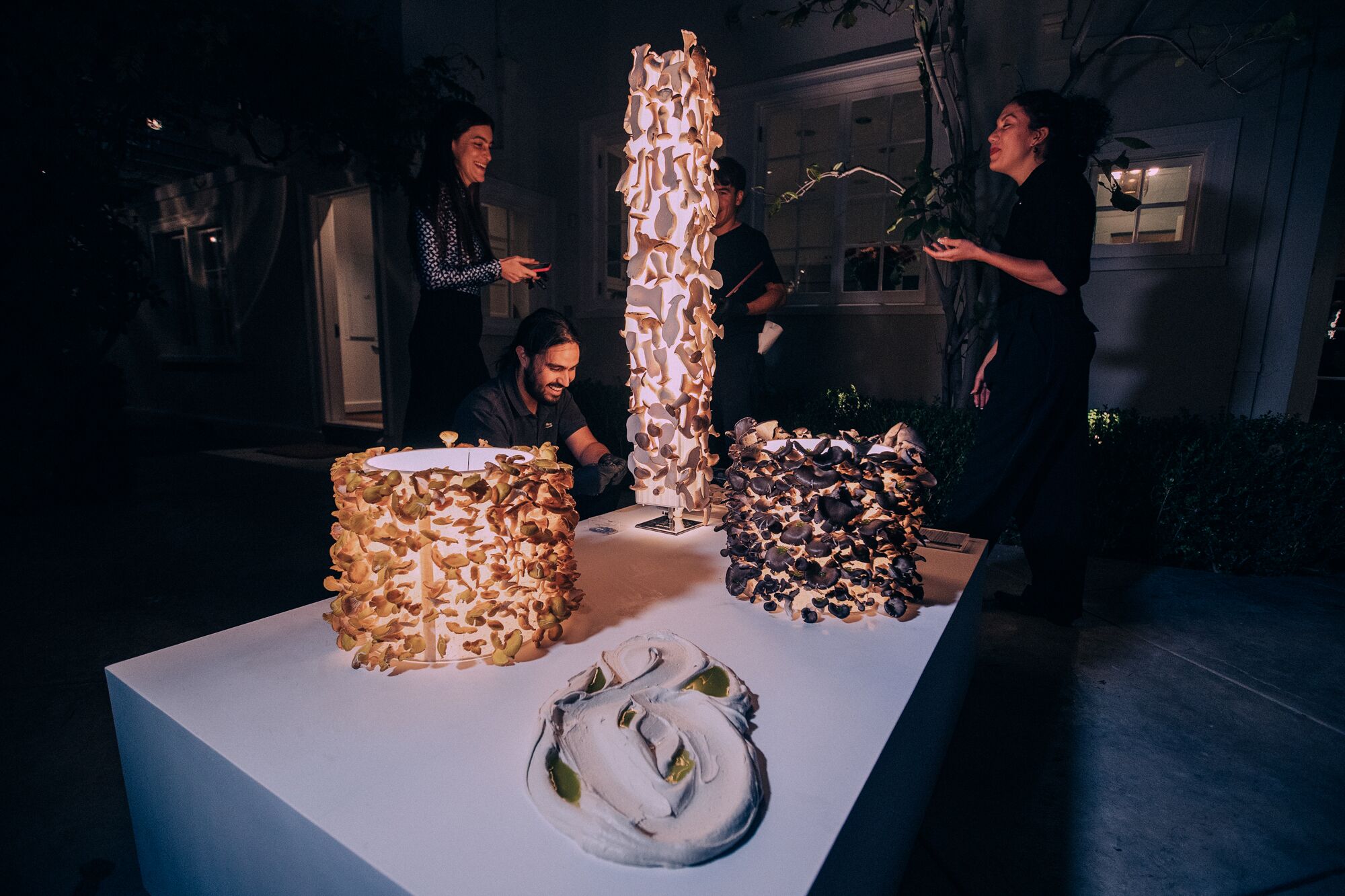
Eléna Petrossian, from left, assistants Luis Echavarria and Miguel Flores, and Verónica González arrange a mushroom-and-light set up titled “Edible Mushroom Lamp.”
(Allen J. Schaben / Los Angeles Instances)
At a grand opening get together in November, hosted by Cultured journal for the Future Excellent — the gallery/residence situated on the former Hollywood house of film producer Samuel Goldwyn — González slices mushrooms within the kitchen whereas Petrossian places the ending touches on a raised platform subsequent to the swimming pool. Constructed with the assistance of two assistants, it serves as the bottom for 3 illuminated lampshades of assorted sizes coated totally with trumpet and oyster mushrooms.
“It’s sort of a paradox to have one thing that appears like it might dwell inside the home however really exterior, and never solely are you able to work together with it,” Petrossian says, “you may eat it too.”
Laura Younger, gallery director of the Future Excellent, walks by the mansion (it’s L.A.’s fourth Future Excellent home, which strikes each couple of years), a posh of gallery and dwelling areas. “We love to stay nomadic as a result of we like to hold altering,” Younger says. “It’s about creating a brand new canvas. So [for the party], why not do meals artwork?”
Petrossian affixed 4,000 straight pins to the three lampshades for hanging the mushrooms. “It took me two days simply to place within the pins. That’s all I did — and watch TV. I didn’t transfer from my sofa,” she says. “My preliminary concept was to stitch every mushroom. However they dry out so shortly, you may’t do it too far prematurely. We needed to give you a option to set up the day of.”
“I like it,” the Future Excellent’s Younger says. “I feel conceptually it’s cool. A part of me needs they had been simply sitting on lamps we’ve got. I really like that they’ve this legendary presence. Wouldn’t it’s loopy if these had been upstairs within the bed room?”
As Petrossian attaches a mushroom slice to every pin, González follows with a brush of soy sauce and rice vinegar marinade, cautious to not stain the lampshades or desk base. “The mushrooms are so good on their very own,” she says. “They simply wanted a kick with salty vinegar.”
In relation to growing dishes, Petrossian says her Armenian background melds with González’s Mexican influences. “After I take into consideration making an attempt one thing, I can already style what it’s going to be.”
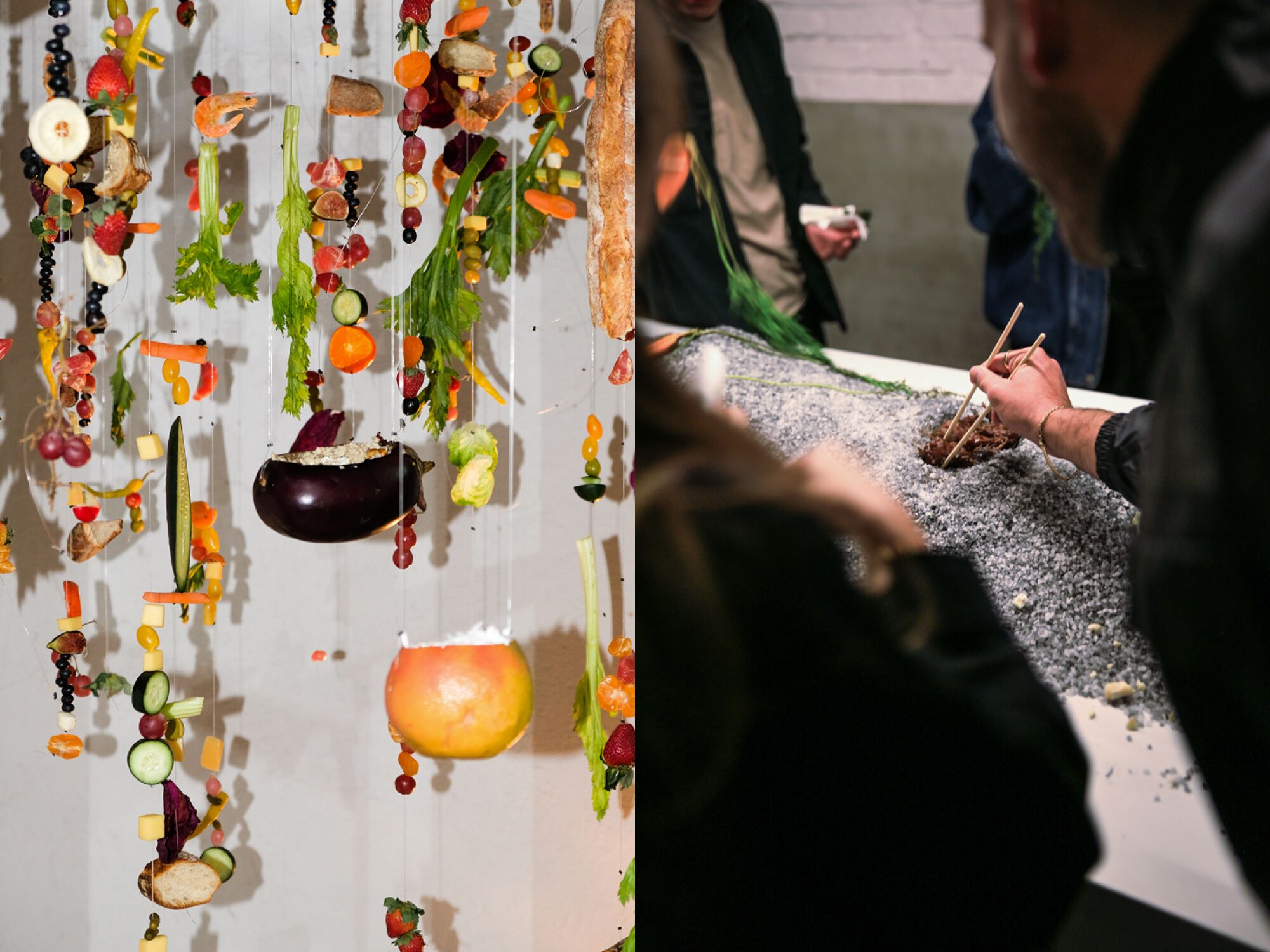
Edible sculptures by Ananas Ananas.
(Ananas Ananas)
“You all the time give you the Center Jap flavors,” says González.
“The saffron, the rose water, these flavors are very house for me,” Petrossian says. “She’ll do the cilantro-jalapeño factor.”
“And a bit garlic. It’s by no means not there,” González says. “Every thing has garlic in it.”
González smears cashew cream immediately onto one nook of the desk base, swooping it into an natural oval form with concave areas that she fills with jalapeño-cilantro-infused olive oil from a squeeze bottle; that is the dip for the mushroom slices. The ultimate contact is a spoonful of translucent inexperienced algae “caviar” positioned into the divot of every yellow oyster mushroom cap.
When visitors arrive, they begin taking cellphone footage of the mushroom lamps however are hesitant to the touch the meals. They bend over the platform to get a better look, and eventually somebody removes a mushroom slice from one of many lampshades and swipes it by the cashew cream. Cilantro-jalapeño oil begins to seep across the outer edges of the dip.
“So summary meals artwork is a part of the factor. I feel the truth that the dip doesn’t have a boundary is inviting,” says Hiroshi Kaneko, an architect at Studio Shamshiri. “And truthfully, I feel that tall one is definitely an ideal lampshade.”

Eléna Petrossian and Verónica González met in Mexico Metropolis and based meals design studio Ananas Ananas, now primarily based in Los Angeles and Ensenada.
(Allen J. Schaben / Los Angeles Instances)
[ad_2]




